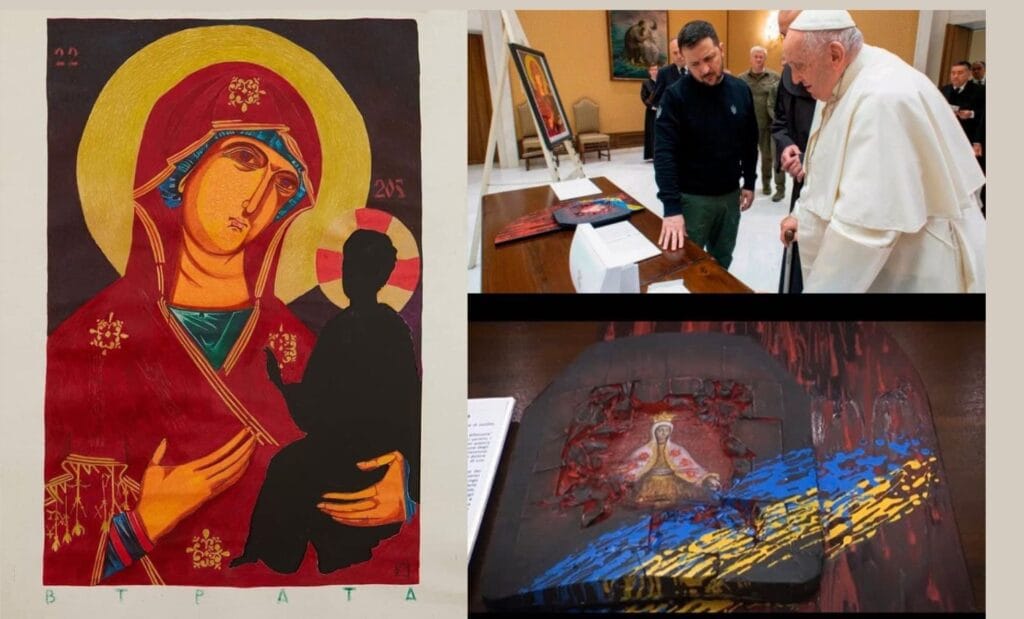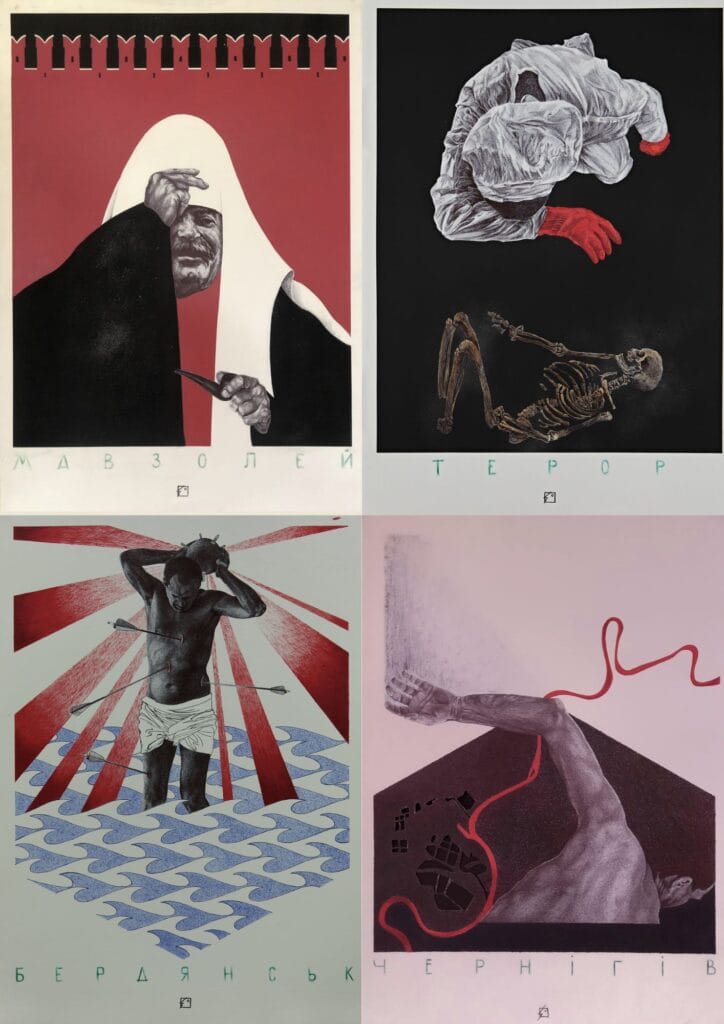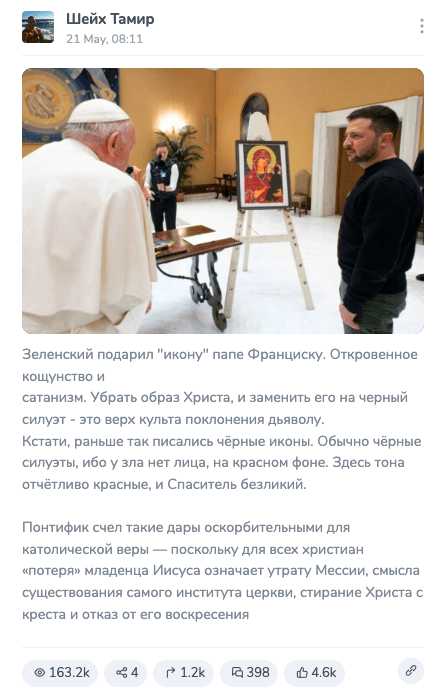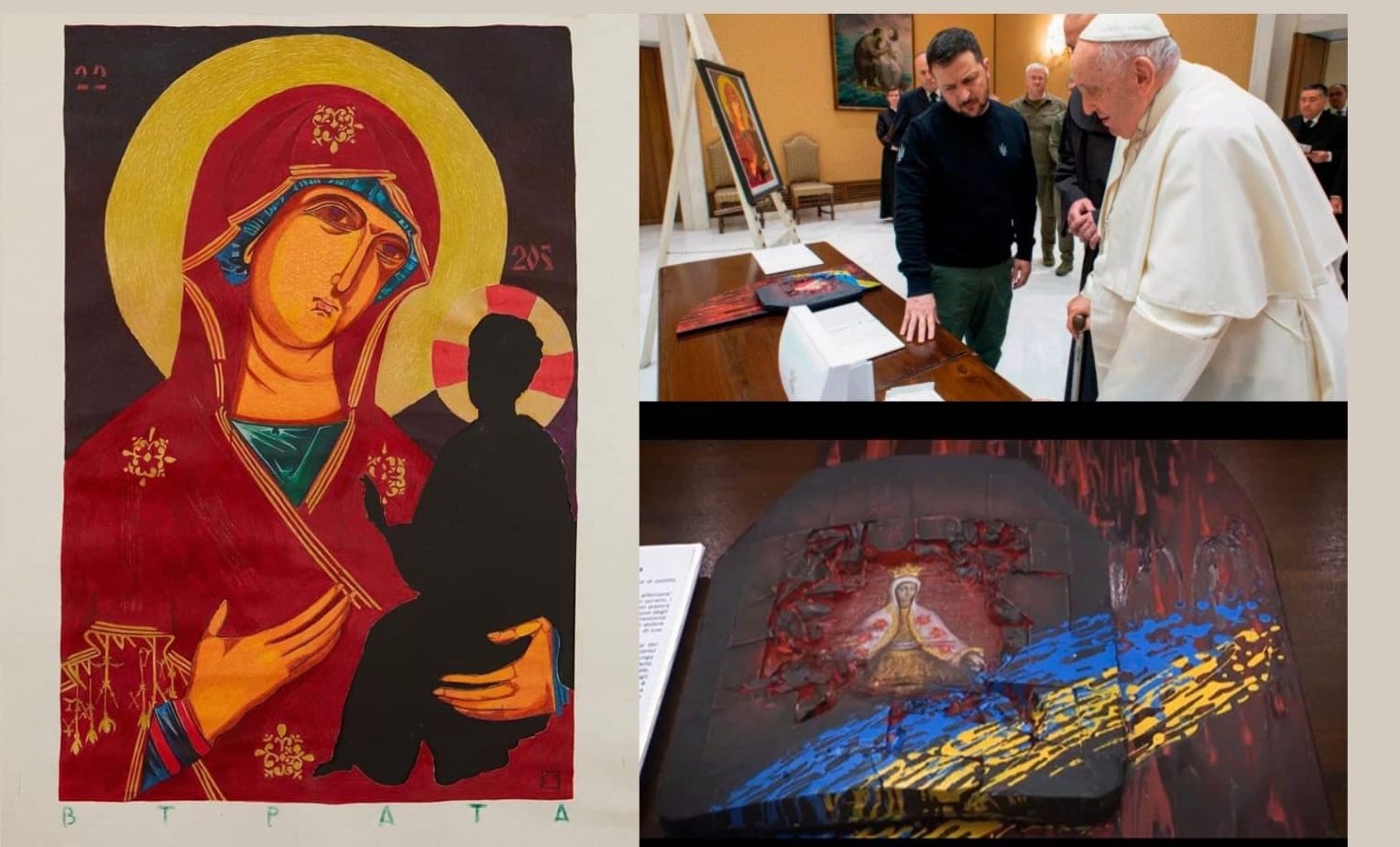In mid-May 2023, a message spread in the Russian-language segment of Telegram and a number of major media outlets that the Pope was allegedly extremely dissatisfied with the gifts from the President of Ukraine. We checked whether there is any basis for such statements.
Starting from May 17, Russian media published a number of materials claiming that Pope Francis was offended by gifts from Ukrainian President Vladimir Zelensky. Similar articles appeared, for example, in TASS, "Arguments and facts», on Lenta.ru. Headlines ranged from neutral (“Zelensky and Pope exchanged unfortunate gifts”) to expressive (“Media: Zelensky insulted the Pope with his gift”). The essence of all the publications was that during the visit Zelensky presented the pope with “an icon of the Mother of God with Christ the Child painted over with black paint,” which symbolizes the loss of Ukrainian children. According to the authors of the notes in the media, Francis allegedly considered such a gift offensive, since “for all Christians, the “loss” of Jesus means the loss of the Messiah and the raison d’être of the church itself.” Some Facebook users on the same day called gift from Zelensky with a “hell icon”, accusing him of Satanism, and one of the numerous publications in LiveJournal was published under title “Zelensky presented the Pope with an image of Astarte with the Antichrist” (Astarte is the Greek version of the name of the goddess Ishtar, closely related with the myth of a dying and reborn god. — Approx. ed.). In Telegram, according to the TGStat service, the story is most widely spread in the period from May 17 to May 21 - in particular, fasting channel “Ukraina.ru” (394,000 views at the time of writing this analysis) was shared by TV presenters Vladimir Solovyov (280,000) and Artyom Sheinin (102,000). As on Facebook, Telegram also called Zelensky’s gift “outright blasphemy” and “Satanism,” claiming that it had previously been so wrote black (adopisque) icons: “Black silhouettes, for evil has no face, on a red background.”
Offended dad
On May 13, 2023, Vladimir Zelensky met with Pope Francis in the Apostolic Palace in the Vatican. During the visit of the Ukrainian leader, they exchanged gifts. The Pope presented the President of Ukraine with a bronze olive branch symbolizing peace, “Document on Human Fraternity for World Peace and Coexistence"(this declaration was signed in 2019 by Francis and the Supreme Imam of Al-Azhar, Sheikh Ahmed al-Tayib), a microbook about the papal Statio Orbis from March 27, 2020 and “Encyclical on Peace in Ukraine.” With some variations this is more or less standard kitwho's dad hands over high-ranking guests. Zelensky gave Francis works by Ukrainian artists stylized as icons: a painting by Alexei Revika “Loss, 2022-58” (the number 58 means the 58th day of the war, this is how the artist marks paintings from a series that he has been painting for more than a year) and a painted plate from a bulletproof vest with the title “Unburnable” by artist Yuri Vakulenko.

The news in the Russian media on May 13 was quite neutral and was retold with different accents publication on the official Vatican News website. The subtext of the gifts is quite clear from both the pope and Zelensky: Francis, while condemning the war and praying for the dead Ukrainians, does not declare direct support for Ukraine and speaks of the need for a peaceful resolution of the conflict, and Revika’s work, donated by Zelensky, symbolically speaks of the country’s losses (the number 205 in the painting symbolizes 205 children killed in combat at the time of writing "Loss" in April 2022), which is a kind of message to the "undecided" dad.
Publications that the works of art brought to the Vatican “offended” the pontiff first appeared only four days after Zelensky’s visit. Their original source is comment left-wing publicist and former senator Raniero La Valle on the website of the daily newspaper Il Fatto Quotidiano, openly occupied in the spring of 2022, a pro-Putin position. La Valle is an ardent supporter of Francis; in 2015 he wrote a book about the pope, and in 2022 he initiated the signing of an open letters to the pontiff with a request to accept the role of peacemaker in negotiations between Moscow and Washington. The publicist himself openly accuses NATO of starting the war in Ukraine, regularly criticizes Vladimir Zelensky and opposes assistance to Kyiv from the European Union.
La Valle himself was not present at the meeting between Zelensky and Francis, and there is no public evidence of his close communication with the pope in recent years, which could indirectly indicate that the author of the column in Il Fatto Quotidiano could know about the pontiff’s attitude towards gifts. Nevertheless, in his text, the publicist says that “the image of the Virgin Mary, donated by Zelensky, denies the crucified and risen Christ.” La Vallee also makes two factual distortions, which will then lead the Russian media and bloggers to “Satanism”: in his description, he combines the features of two works donated to the pontiff into one, claiming that the painting “Loss” was painted on a plate from a bulletproof vest, and calls it an icon.
“An icon painted on a plate from a bulletproof vest” sounds quite unexpected, but the Orthodox canon does not limit the icon painter in the choice of material on which the image will be applied, and “armor-painted icons” are by no means a fiction. For example, on May 23, the Primate of the Orthodox Church of Ukraine, Metropolitan Epifaniy consecrated 12 icons written on plates from body armor.
These icons were painted by a group of Ukrainian artists "ArtArmor”, which for some time now has been using armored plates handed over to them from the front lines instead of canvas, using, among other things, icon-painting techniques and subjects. “The Unburnt”, presented to the pontiff by artist Vakulenko, is one of these works. But it could not be consecrated for two reasons: firstly, purely chronologically, and secondly, all the icons consecrated by Epiphanius were strictly maintained in accordance with the Orthodox canon, which cannot be said about Vakulenko’s work. In the strict sense, an icon in principle can't neither Vakulenko’s work nor Revika’s work, which is generally part a large conceptual series, for which iconography is only one of the motives.

It is characteristic that La Valle does not use in the text of your publication the words “offended” or “offensive”. He calls Zelensky’s gifts only “erroneous”; this is reflected in the title, which literally translates as “Zelensky was mistaken even with gifts for dad.” Allegations of insult to Francis appear to have appeared in later retellings of the column.
Neither the pope himself nor Vatican sources publicly or anonymously expressed dissatisfaction with Zelensky's gifts. Both "Loss, 2022-58" and "Unburnt" are mentioned in the official meeting report and shown in video on the official Vatican News channel, while in the description on all available In the site’s languages, both works are called “works of art.” All publications we found about the insulted pope in English and Italian refer to Il Fatto Quotidiano or are translations of later texts from Russian media. Judging by the publications available on the Internet, the feelings of Raniero La Valle himself were most hurt.
Not true
Satanic icon
Satanism in Zelensky's gifts on May 16 reviewed publicist Roman Golovanov. At his suggestion, this version began to spread, first on Facebook, then on blogs, and then in Telegram and in Media. Following La Valle, Golovanov also mixed two works into one, and Revika’s painting also turned out to be “an icon painted on the remains of a bulletproof vest.”

Publications that followed Golovanov’s post added the epithets “hello” and “black” to the description.

At the same time, hellish and black icons are terms with specific meanings. In folklore and art history, the hellish icon described as an object of black magic. Allegedly, a canonical image is applied on top of the image of demons and Satan (or any other hellish subject), and a person who prays to such an icon thinks that he is praying to a saint or the Mother of God, but in fact he is praising the devil. The existence of hellish icons does not have sufficient evidence and is considered by folklorists to be a myth. It is not hellish icons that are called black, but simply icons that have darkened over time (accordingly, icons after restoration are called red). It is in this sense that the phrase “black icon” is used, for example, in description acquisition by the Russian Orthodox Church of the Sovereign Icon of the Mother of God. The connotation of the black icon as satanic, judging by the available data and search in the National Corpus of the Russian Language, - a subcultural remake, marketing an invention for connoisseurs of neo-pagan esotericism and musical genres, one way or another connecting themselves with the demonic principle.
Thus, the assertion about the satanic essence of the works of Ukrainian artists is unfounded. We are faced with a series of distortions. First, one of the works with a reference to icon painting is called an icon in the press, then two authors, Russian and Italian, having superficially read the description of Zelensky’s visit to Pope Francis, mix the two works into one, and under the influence of bias and a number of superstitions, bloggers come up with a final fantastic story.
Cover image: More On / Pixabay
Not true
If you find a spelling or grammatical error, please let us know by highlighting the error text and clicking Ctrl+Enter.






